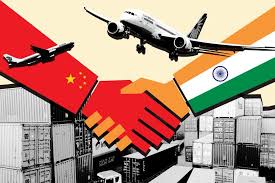
A series of high-level encounters, negotiated border arrangements and pragmatic economic moves have shuffled India and China away from the deep freeze that followed their deadly 2020 clash, opening a cautious—but consequential—rapprochement between the two Asian giants. Over the past year, both capitals have balanced security hedging with concrete steps to unclog trade ties and reduce frontline tensions, driven by a mix of domestic priorities, regional geopolitics and commercial incentives.
Leaders’ diplomacy and the October patrolling pact
The diplomatic thaw that has gathered pace was seeded at the top. A flurry of summit meetings and ministerial visits culminated in a formal agreement on border patrolling arrangements late last year that eased a four-year military standoff in parts of eastern Ladakh. That deal—negotiated after lengthy local-level talks—reestablished patrolling norms at specific friction points, and created predictable routines intended to prevent accidental face-offs between patrols and reduce the risk of a repeat of the hand-to-hand violence seen in 2020. The political effect was immediate: with the visible signs of desanguination on the line, both governments found it easier to pursue talks on trade, people-to-people exchanges and multilateral engagement.
At the same time, face-to-face meetings between leaders have helped reset the tone. Bilateral encounters on the sidelines of regional gatherings sent public signals of willingness to manage differences rather than allow them to define the relationship. Those gestures—handshakes, mutual acknowledgements of the need for stability and carefully worded communiqués stressing partnership—have been carefully choreographed to reassure domestic audiences while opening political space for officials to complete technical workstreams.
Economic levers and commercial incentives
Beyond geopolitics, economic interdependence played a central role in bringing the two sides closer. India’s trade deficit with China has become an increasingly prominent concern in New Delhi, prompting bilateral talks aimed at addressing market access, non-tariff barriers and specific export-control frictions. At the same time, Beijing has shown willingness to unclench on certain export curbs that had provoked anxiety in New Delhi—moves that helped create positive momentum for broader engagement. The easing of restrictions on several industrial items and equipment signalled — at least temporarily — a readiness in Beijing to make commercial concessions to smooth ties and preserve supply linkages.
Commercial interests also pushed private actors to lobby for normalisation. Indian industries reliant on Chinese inputs, and Chinese firms with investments or supply chains tied to the Indian market, pressed their governments to reduce friction. Resumption of key trade flows and the promise of restored services—such as resuming direct flights and facilitating pilgrimages and tourist travel—offer immediate economic relief for sectors hit by years of curtailed cross-border movement, strengthening the case in both capitals for practical problem-solving.
Domestic imperatives have been a powerful driver of the rapprochement. Both governments face internal economic and political pressures that make prolonged confrontation costly. New Delhi has been keen to protect investors, reduce inflationary pressures linked to supply disruptions, and safeguard infrastructure projects that rely on imported components. Beijing, meanwhile, has its own priorities—maintaining stable neighbourhood relations, securing trade routes, and insulating supply chains at a time of increasing geopolitical competition. These overlapping incentives created a window in which both sides could recalibrate.
Leaders in New Delhi and Beijing also appear to have been motivated by the broader international environment. Intensifying great-power competition, shifting trade policies in Western capitals and the economic unpredictability of key markets have encouraged Asian actors to explore strategic autonomy through managed engagement rather than open confrontation. For India, a more stable northern frontier and workable economic ties with China reduce the risk of being drawn into polarised blocs; for China, normalised ties with India help preserve market access and regional influence.
Confidence-building measures and people-to-people ties
Practical confidence-building measures have accompanied political agreements. Both sides have expanded mechanisms for military communications, resumed restricted categories of travel for pilgrims and tourists, and flagged the reopening of direct commercial air links that had been suspended since the border tensions flared. Incremental steps—such as simplifying visa protocols for specific categories and permitting religious visits to Tibetan sites—have both symbolic and material value: they signal normalization at a social level and immediately benefit constituencies that can influence policy-makers.
These measures are fragile but meaningful. They create daily-life incentives for officials and businesses to keep the relationship on a steady track; resuming pilgrimages and restoring connectivity undercuts narratives that only confrontation defines India-China ties, allowing nationalist rhetoric to be tempered by the practical benefits of cooperation.
Despite the momentum, deep strategic mistrust and unresolved structural issues remain. The border agreement covers specific sectors rather than the entire 3,800-kilometre frontier, and it leaves unresolved bigger questions about territorial claims and force postures. Historic irritants—such as the presence of the Dalai Lama in India, large Chinese projects in neighbouring Pakistan, and environmental anxieties over Himalayan dam projects—still feed scepticism in Indian strategic circles. Moreover, the bilateral trade imbalance and complaints about market access continue to be a source of friction that can quickly re-ignite tensions if not managed through sustained dialogue.
What to watch next
The durability of the rapprochement will hinge on follow-through: whether technical committees can translate political promises into verifiable implementation on the border; whether trade facilitation measures are matched by steps to address structural complaints such as non-tariff barriers; and whether both sides can compartmentalise competition while expanding cooperation in areas of mutual interest—climate, connectivity and multilateral diplomacy in forums where both seek a larger voice.
In the near term, incrementalism is likely to be the operating model: pragmatic, cautious, and reversible. That may be exactly what both capitals want—a slower, safer unwinding of tensions rather than a dramatic reset. For now, New Delhi and Beijing have chosen to manage their differences through negotiation and selective accommodation, driven by overlapping economic incentives, political calculations and an appetite to avoid renewed violence along the frontier. Whether this careful rapprochement blooms into a durable strategic accommodation or remains a temporary pause will depend on how well the two sides translate words into on-the-ground stability and concrete commercial outcomes.
(Source:www.ft.com)
Leaders’ diplomacy and the October patrolling pact
The diplomatic thaw that has gathered pace was seeded at the top. A flurry of summit meetings and ministerial visits culminated in a formal agreement on border patrolling arrangements late last year that eased a four-year military standoff in parts of eastern Ladakh. That deal—negotiated after lengthy local-level talks—reestablished patrolling norms at specific friction points, and created predictable routines intended to prevent accidental face-offs between patrols and reduce the risk of a repeat of the hand-to-hand violence seen in 2020. The political effect was immediate: with the visible signs of desanguination on the line, both governments found it easier to pursue talks on trade, people-to-people exchanges and multilateral engagement.
At the same time, face-to-face meetings between leaders have helped reset the tone. Bilateral encounters on the sidelines of regional gatherings sent public signals of willingness to manage differences rather than allow them to define the relationship. Those gestures—handshakes, mutual acknowledgements of the need for stability and carefully worded communiqués stressing partnership—have been carefully choreographed to reassure domestic audiences while opening political space for officials to complete technical workstreams.
Economic levers and commercial incentives
Beyond geopolitics, economic interdependence played a central role in bringing the two sides closer. India’s trade deficit with China has become an increasingly prominent concern in New Delhi, prompting bilateral talks aimed at addressing market access, non-tariff barriers and specific export-control frictions. At the same time, Beijing has shown willingness to unclench on certain export curbs that had provoked anxiety in New Delhi—moves that helped create positive momentum for broader engagement. The easing of restrictions on several industrial items and equipment signalled — at least temporarily — a readiness in Beijing to make commercial concessions to smooth ties and preserve supply linkages.
Commercial interests also pushed private actors to lobby for normalisation. Indian industries reliant on Chinese inputs, and Chinese firms with investments or supply chains tied to the Indian market, pressed their governments to reduce friction. Resumption of key trade flows and the promise of restored services—such as resuming direct flights and facilitating pilgrimages and tourist travel—offer immediate economic relief for sectors hit by years of curtailed cross-border movement, strengthening the case in both capitals for practical problem-solving.
Domestic imperatives have been a powerful driver of the rapprochement. Both governments face internal economic and political pressures that make prolonged confrontation costly. New Delhi has been keen to protect investors, reduce inflationary pressures linked to supply disruptions, and safeguard infrastructure projects that rely on imported components. Beijing, meanwhile, has its own priorities—maintaining stable neighbourhood relations, securing trade routes, and insulating supply chains at a time of increasing geopolitical competition. These overlapping incentives created a window in which both sides could recalibrate.
Leaders in New Delhi and Beijing also appear to have been motivated by the broader international environment. Intensifying great-power competition, shifting trade policies in Western capitals and the economic unpredictability of key markets have encouraged Asian actors to explore strategic autonomy through managed engagement rather than open confrontation. For India, a more stable northern frontier and workable economic ties with China reduce the risk of being drawn into polarised blocs; for China, normalised ties with India help preserve market access and regional influence.
Confidence-building measures and people-to-people ties
Practical confidence-building measures have accompanied political agreements. Both sides have expanded mechanisms for military communications, resumed restricted categories of travel for pilgrims and tourists, and flagged the reopening of direct commercial air links that had been suspended since the border tensions flared. Incremental steps—such as simplifying visa protocols for specific categories and permitting religious visits to Tibetan sites—have both symbolic and material value: they signal normalization at a social level and immediately benefit constituencies that can influence policy-makers.
These measures are fragile but meaningful. They create daily-life incentives for officials and businesses to keep the relationship on a steady track; resuming pilgrimages and restoring connectivity undercuts narratives that only confrontation defines India-China ties, allowing nationalist rhetoric to be tempered by the practical benefits of cooperation.
Despite the momentum, deep strategic mistrust and unresolved structural issues remain. The border agreement covers specific sectors rather than the entire 3,800-kilometre frontier, and it leaves unresolved bigger questions about territorial claims and force postures. Historic irritants—such as the presence of the Dalai Lama in India, large Chinese projects in neighbouring Pakistan, and environmental anxieties over Himalayan dam projects—still feed scepticism in Indian strategic circles. Moreover, the bilateral trade imbalance and complaints about market access continue to be a source of friction that can quickly re-ignite tensions if not managed through sustained dialogue.
What to watch next
The durability of the rapprochement will hinge on follow-through: whether technical committees can translate political promises into verifiable implementation on the border; whether trade facilitation measures are matched by steps to address structural complaints such as non-tariff barriers; and whether both sides can compartmentalise competition while expanding cooperation in areas of mutual interest—climate, connectivity and multilateral diplomacy in forums where both seek a larger voice.
In the near term, incrementalism is likely to be the operating model: pragmatic, cautious, and reversible. That may be exactly what both capitals want—a slower, safer unwinding of tensions rather than a dramatic reset. For now, New Delhi and Beijing have chosen to manage their differences through negotiation and selective accommodation, driven by overlapping economic incentives, political calculations and an appetite to avoid renewed violence along the frontier. Whether this careful rapprochement blooms into a durable strategic accommodation or remains a temporary pause will depend on how well the two sides translate words into on-the-ground stability and concrete commercial outcomes.
(Source:www.ft.com)





